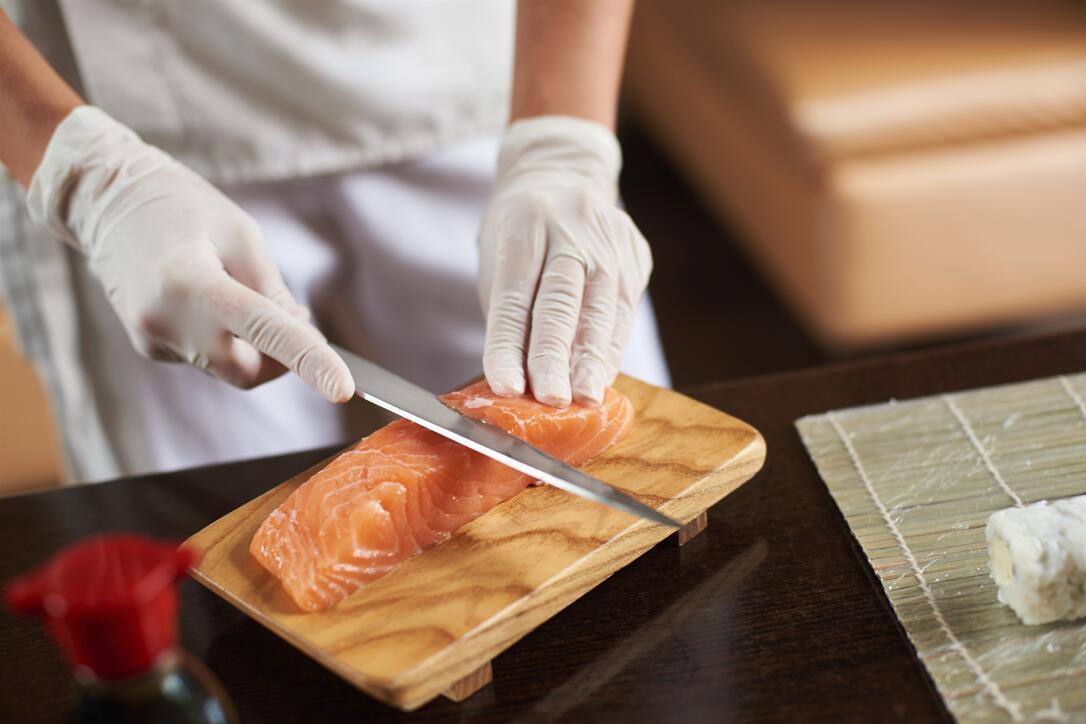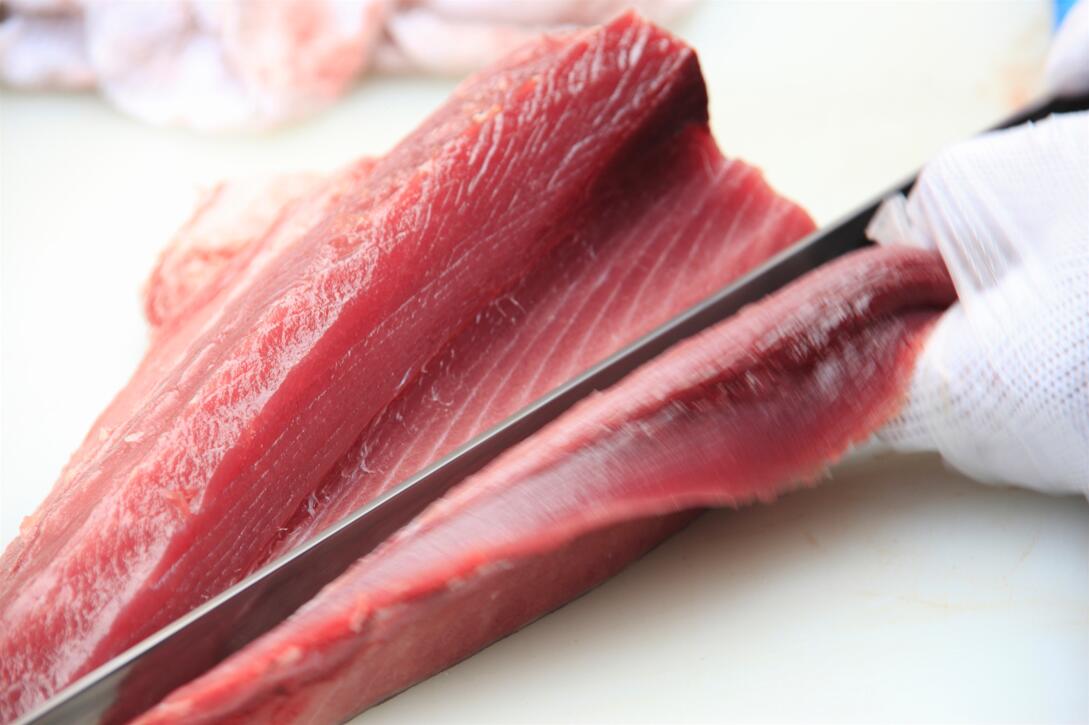Japan is one of the leading countries in seafood consumption, and it has been this way for centuries. Japanese cuisine revolves around seafood, and the tools needed to prepare dishes are somewhat different than those found in the western hemisphere.
When thinking about slicing and filleting fish, a handful of Japanese kitchen knives come to mind. These are Sujihiki and Yanagiba. This article will detail the characteristics of Sujihiki and Yanagiba, compare the two, help you decide on which one to get, and briefly go over other Japanese fish knives.
Table of contents
What is Sujihiki?

Translating from Japanese to fresh slicer, Sujihiki is one of the main slicing knives. Sujihiki is primarily used for slicing fish and boneless meats. It’s basically the Japanese equivalent of a carving knife, but a lot thinner. After all, Japanese cuisine requires lots of delicate and thinly sliced cuts.
Sujihiki characteristics
- Sujihiki features a narrow blade between 8 and 12 inches long.
- The edge is double beveled like western kitchen knives.
- Sujihiki has a thin blade profile. At its spine, the widest point, it’s 2mm to 3mm thick.
- As it’s a popular specialty knife, Sujihiki comes with both carbon steel and stainless steel options.
- Sujihiki has a pointy tip that makes slits easier to remove unwanted fats and tissue.
Sujihiki uses
Sujihiki is your typical carving knife with a Japanese touch. The narrow blade creates little friction, allowing you to easily slide the blade through the meats while ensuring the slices are tear-free. The primary uses of Sujihiki include carving boneless animal protein and filleting large fish in a single sweep. Anything you can do with a carving knife, you can do so with a Sujihiki.
What is Yanagiba?

Yanagiba, also known as Yanagi or sushi knife, is very similar to the Sujihiki in terms of blade design. The difference is at the blade’s edge, where the distinction comes. Unlike Sujihiki, Yanagiba is a single bevel knife. A double bevel kitchen knife has a V-shaped edge grounded equally on both sides, whereas a single bevel knife like the Yanagiba has only one side forming the cutting edge.
Yanagiba’s single bevel edge and the narrow blade profile make it excellent at thinly slicing fish as well as filleting. This makes Yanagiba the perfect sushi knife. Countless Japanese sushi chefs rely on their Yanagiba to prepare fish.
Yanagiba characteristics
- Yanagiba has a narrow blade that’s 8 to 14 inches long.
- It has a single bevel edge, which changes the way you cut and sharpen the knife.
- The single bevel edge and the blade design make it one of the best knives to fillet and slice fish in one clean motion.
- Yanagiba has a thicker blade than the Sujihiki at 0.35mm to 0.45mm.
- Most Japanese Yanagiba is made from carbon steel, with other steel options.
Yanagiba uses
Yanagiba is referred to as the sushi knife as it’s primarily used for cutting raw fish. Though it’s somewhat thick at the spine, Yanagiba has a slightly thinner edge than most Japanese kitchen knives, including Sujihiki. Japanese chefs utilize Yanagiba in all aspects of sushi making and any other dish requiring thinly sliced fish. In addition to fish, Yanagiba is also good for cutting any raw boneless meats, especially if thin slices are what you’re looking to get.
Comparison: Sujihiki and Yanagiba differences
At first glance, both knives look pretty identical, but with a closer look, you’ll spot some of the differences that make each knife unique. Here is a rundown of the differences between Sujihiki and Yanagiba.
Edge
The edge difference between the Sujihiki and Yanagiba knife is where the real difference shows up. Much of the distinction between the single bevel and double bevel kitchen knives apply to the differences in Sujihiki and Yanagiba. Because the blades are similarly designed, it changes how you cut, slice, and fillet with the knife.
When you cut an ingredient with Sujihiki, whether it’s raw fish, meat, or vegetables and fruits, the food that’s cut is pushed on both sides. This creates an even, flat slice. The Yanagiba knife is just as delicate and precise, but the single bevel edge moves the food in one direction, all while steering towards the cutting angle.
This difference may not seem a big deal at first. That could be true to some extent. For example, Sujihiki will cut a tomato perfectly in half in a straight line, but Yanagiba will pull towards the cutting angle. This isn’t something that matters as much, but when butchering certain meats like beef and lamb, this can tear the slices and create unwanted resistance on the edge, which can damage the blade altogether.
It also has to do with the way you hold the knife. If you cut against the cutting edge with Yanagiba, meaning that you flip the knife or slice from left to right, it can both damage the ingredient and the knife’s edge. However, this depends on where the cutting edge is formed. Learn more about the differences in single bevel knives for left and right-handed cooks.
Additionally, the edge on Yanagiba is much thinner than Sujihiki. The thinner edge gives a sharper blade overall and makes cutting and slicing easier.
Blade
The way the blade is designed in Sujihiki and Yanagiba is pretty much the same, except for the attributes of single and double bevel edges. Because the cutting angle is formed on only one side in single bevel knives, the other is flat. This isn’t the same with double bevel alternatives, where the blade is grounded equally on both sides, creating a V cutting edge.
This difference between Sujihiki and Yanagiba can be identified on the blade. You take a Sujihiki, and the edge is just like any other western kitchen knife. Yanagiba, on the other hand, is not so much. One side of the blade is completely flat as if it was a piece of steel, not a blade. Flip it over, and you’ll reveal where the cutting edge is grounded. Other than these, both look pretty much identical.
Weight
Even though Yanagiba has a thinner edge than Sujihiki, it’s generally heavier. This excess weight is mainly due to the thicker spine. Japanese chefs prefer putting their forefinger on the knife’s spine to apply downward pressure. A slight pressure on the spine allows the chef to move the blade precisely as if it was an extension of their arm, perfect for preparing raw fish for sushi and sashimi.
The extra weight in Yanagiba aids in slicing fish vertically and creates less friction. The result of this is tear-free slices that are intact. As this is the outcome you’d want when cutting fish, considering it’s a lot more delicate than beef or poultry, Yanagiba’s extra weight becomes an advantage.
The lightweight of Sujihiki could also be advantageous, depending on your preferences. A knife lighter in weight is always better when using it for prolonged periods. It will put less strain on your wrist, and you’ll be able to work for hours at a time comfortably.
Purpose

Both the Sujihiki and Yanagiba are specialty knives, but one is more versatile than the other. Sujihiki is an all-rounder carving and slicing knife that you can utilize to cut any ingredient that isn’t dense.
This means no large cuts of meats with bones as it won’t be able to cut through them, but overall great for deboning. Not to say that Yanagiba can’t handle these – just not as proficient as the Sujihiki.
That said, wherever the long narrow blade may come in handy, you can use Sujihiki – but Yanagiba, not so much. If it’s solely filleting and slicing fish you’re after, Yanagiba is a far better option than Sujihiki, as it is the intended purpose of the knife. However, when you need something versatile enough to take on other ingredients than just fish, including vegetables and fruits, you’ll find Sujihiki to be a more suitable knife.
Steel
Traditional Japanese knives are made from carbon steel. This applies to both Sujihiki and Yanagiba.
Since Sujihiki is more versatile and a better kitchen knife for western cuisine, it’s more popular. You can utilize Sujihiki for meats, poultry, and other boneless animal protein. These additional uses than just filleting and slicing fish make it an all-rounder carving and slicing knife with a Japanese touch, making it a great alternative to the typical carving knife.
One difference in western knives is that they’re almost always made from stainless steel. The idea of possessing a kitchen knife that doesn’t have anti-corrosive attributes isn’t a good one for many European and American cooks. As Sujihiki is more prevalent in the West than Yanagiba, stainless steel options are more apparent. It might be challenging to find a Japanese Yanagiba knife made from stainless steel, whereas a stainless steel Sujihiki is easy to find.
Which one should you choose?
Right off the bat, we can say that if you’re a home cook, you’re mostly better off with a Sujihiki. If you’re filleting and slicing fish on a commercial scale, Yanagiba is a much superior knife that will speed up a lot of the things you’re already doing.
Look at the ingredients you cut and see if the single bevel edge would be beneficial or a disadvantage. This alone can help you decide on the right knife for the job. However, as with any other kitchen knife, many variables go into it. If you’re willing to spend a sizeable amount of money on knives, why not get both? Use Sujihiki on meats and poultry and take out the Yanagiba for fish.
All in all, though, Sujihiki is generally a better option for home cooks due to its versatility. In contrast, a Yanagiba would be more suitable if you prepare fish every day.
Alternatives to Sujihiki and Yanagiba
There are other Japanese kitchen knives similar to Sujihiki and Yanagiba – at least for slicing and filleting. You might find the following knives more appropriate for the tasks you have in mind.
Deba
In terms of intention, Deba is very comparable to Yanagiba, but it has a totally different blade design. The biggest challenge with narrow blades is removing the head when working with fish. Japanese Deba has a considerably thick spine that allows making powerful cuts and a thin edge to cut a fillet in a single sweep. Perfect for filleting fish from start to finish.
Takobiki

Like Sujihiki and Yanagiba, Takobiki has a long narrow blade but with a blunt end. It has a thinner blade than Yanagiba that serves the same purpose – to fillet and slice fish. It’s mainly used for preparing sashimi. The story goes it was disrespectful for chefs to point their knives at their customers, especially nobility, and the Takobini’s flat, blunt edge somewhat was okay. The rectangular shape of the blade makes the knife well-balanced and makes it easier to cut problematic ingredients.
Kiritsuke
Unlike other knives listed in this article, Kiritsuke isn’t exactly a specialty knife. It’s seen as a combination of Yanagiba and Usuba, the Japanese vegetable knife. Many chefs use Kiritsuke to both slice fish and prepare vegetables. The flat edge allows Japanese chefs to chop and dice ingredients effortlessly. Although you can use Kiritsuke as a slicer, it’s one of the few all-rounder Japanese knives that can be utilized in many tasks.
Learn more about Kiritsuke.
Conclusion
Both Yanagiba and Sujihiki are great Japanese knives that can benefit you. Get a Yanagiba to fillet and slice if you work with fish regularly. Just mind the single bevel edge as it’s more delicate.
On the other hand, if an all-rounder slicer to make fine cuts on all boneless animal proteins is what you need, Sujihiki is the knife that will significantly assist you in the kitchen. Get yourself a nice salmon knife in HDMD collection here.









